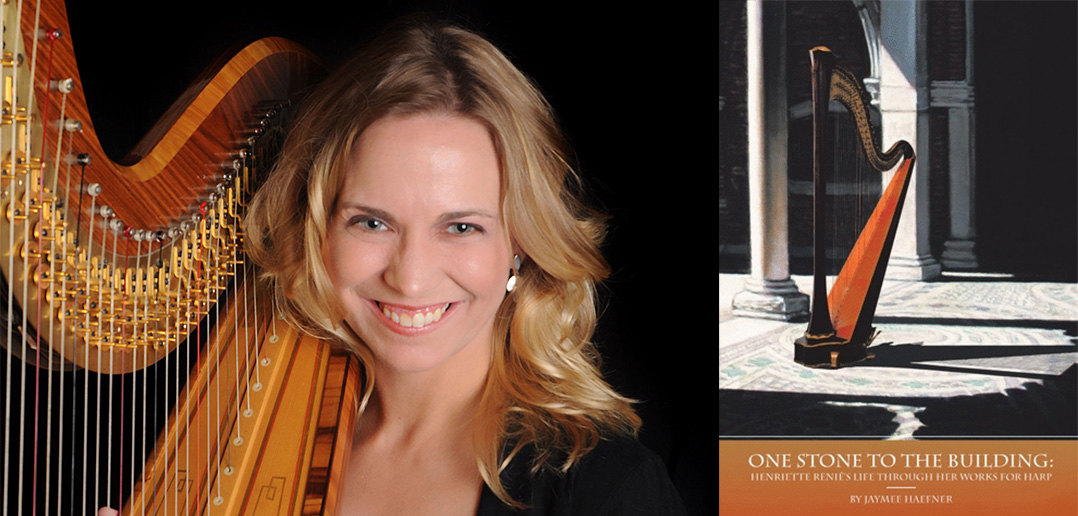A new biography of Henriette Renié (1875-1956), by Jaymee Haefner, promises to illuminate the life of this legendary French harpist. One Stone to the Building chronicles Renié’s life’s work.
What can readers expect from One Stone to the Building?
“This book is a biography of sorts,” says Haefner, “but it focuses on several of Renié’s compositions in detail, describing her life through her tripartite career as a virtuoso, composer, and teacher. In addition to the complete works list, which was updated and re-printed in this book, the appendix includes a series of three radio interviews with Renié, commemorating her 80th birthday.”
Amid the richness of information contained in One Stone to the Building, Haefner also conveys the sense of wonder and inspiration she has drawn from Renié’s life. When asked what was the most interesting thing she has discovered about Renié, she says: “I’m most fascinated by the merge of opposites in Renié’s life. She was a devout Catholic but was fascinated by the occult stories of Poe. She was reverent but could also be feisty, according to her students’ stories. She was petite, but her influence was massive. Most of all, it’s interesting that she found a way to be so successful in a lifetime which spanned two world wars, and in a musical world which was dominated by men. She somehow managed to elevate the harp’s stature despite all of these challenges.”
About the Author
Author Jaymee Haefner – Professor of Harp and Director of Undergraduate Studies at the University of North Texas College of Music – is uniquely qualified to bring this story to life. Her interest in Renié began from her first harp lessons, with Anna Vorhes. “Anna Vorhes studied with Carrol McLaughlin, who studied with Susann McDonald, who studied with Henriette Renié,” Haefner explains. “I suppose you could call Renié my great-great grandmother of the harp.” Since then, she hasn’t stopped digging, to find out everything she could about the woman behind the music. When she entered the doctoral degree program of the Indiana University Jacobs School of Music, under the instruction of Susann McDonald herself, she chose Renié as the focus of her studies. “My main resources came from the International Harp Archives,” says Haefner, “including Renié’s personal writings about her compositions, her recital programs, her letters of correspondence with well-known musicians of her time, and many documents which had been collected and preserved by her goddaughter, Francoise des Varennes…The perspective from Renié’s students is also an important part of her legacy, so I conducted interviews with Susann McDonald and Sally Maxwell as part of this research.”
The Evolution of a Book
Along the way, Haefner published an English version of The Legend of Henriette Renié – a short biography written by one of Renié’s students, Odette de Montesquiou – translated by Robert Kilpatrick. Her doctoral research took her much deeper, however, and eventually culminated in a dissertation, titled Virtuoso, Composer, and Teacher: Henriette Renié’s Compositions and Transcriptions for Harp in Perspective. Ten years later, this new book is a reworking of her dissertation, which Haefner spent the over half a year revising, editing, and adding new information to. “In order to republish this work,” says Haefner, “I updated some of the research, added photographs, acquired all of the necessary rights for the illustrations, and added footnotes to inform the content throughout the book.”
Renié’s Legacy
In her own performing and teaching, Haefner admits that Renié’s influence has touched everything she does. “Her Method is my go-to resource, especially because her solutions are interchangeable with many styles of playing. In particular, her solutions for common harp repertoire and excerpts are invaluable. I particularly like her quote, ‘If you need to use your big toe to get a good sound, do it!’ Humorous as this is, she insisted that a good tone was paramount, and acknowledged that each student may need to achieve that goal in an individual way. She constantly searched for the key to unlocking students’ potential. Now, this has become my mantra as a harp teacher…She is someone I wish I could have met. I certainly have a list of questions I’d like to ask her.” Though Renié herself is no longer around to answer our questions, One Stone to the Building may be the next best thing.

A photo of Henriette Renié, from the back cover of One Stone to the Building.













